Alcatraz Island
Alcatraz Island (/ˈælkəˌtræz/, Spanish pronunciation: [al-ka-tɾas] (Latin America)/Spanish pronunciation: [al-ka-tɾaθ] (Spain)[4] from Arabic: غطاس, romanized: al-ġaţţās, lit. 'gannet ("the diver")') is located in San Francisco Bay, 1.25 miles (2.01 km) offshore from San Francisco, California, United States.[1] The small island was developed with facilities for a lighthouse, a military fortification, a military prison, and a federal prison from 1934 until 21 March 1963. The water currents around the island were high at all times, which presumably decreased the chance of an inmate escaping.[5] Beginning in November 1969, the island was occupied for more than 19 months by a group of Native Americans from San Francisco, who were part of a wave of Native American activism across the U.S., with public protests through the 1970s. In 1972, Alcatraz became part of Golden Gate National Recreation Area and received designation as a National Historic Landmark in 1986.
| Alcatraz Island | |
|---|---|
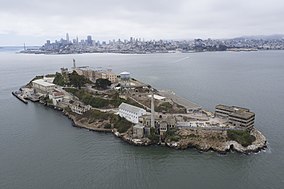 Alcatraz Island, San Francisco Bay, August 11, 2020 | |
   | |
| Location | San Francisco Bay, California, U.S. |
| Nearest city | San Francisco, California |
| Coordinates | 37°49′36″N 122°25′22″W |
| Area | 22 acres (8.9 ha)[1] |
| Established | 1934 |
| Governing body | National Park Service |
| Website | Alcatraz Island |
Alcatraz | |
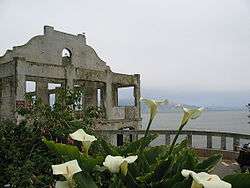 The Social Hall, destroyed by fire during the Native American occupation. | |
| Area | 47 acres (19 ha)[2] |
| Built | 1847 |
| Architect | U.S. Army, Bureau of Prisons; U.S. Army |
| Architectural style | Mission/Spanish Revival |
| NRHP reference No. | 76000209[2] |
| Significant dates | |
| Added to NRHP | June 23, 1976[2] |
| Designated NHLD | January 17, 1986[3] |
Today, the island's facilities are managed by the National Park Service as part of Golden Gate National Recreation Area; it is open to tours. Visitors can reach the island in a little under 15 minutes by ferry ride from Pier 33, located between the San Francisco Ferry Building and Fisherman's Wharf, San Francisco. Hornblower Cruises and Events, operating under the name Alcatraz Cruises, is the official ferry provider to and from the island.
Alcatraz Island is home to the abandoned prison, the site of the oldest operating lighthouse on the West Coast of the United States, early military fortifications, and natural features such as rock pools and a seabird colony (mostly western gulls, cormorants, and egrets). According to a 1971 documentary on the history of Alcatraz, the island measures 1,675 feet (511 m) by 590 feet (180 m) and is 135 feet (41 m) at highest point during mean tide.[6] The total area of the island is reported to be 22 acres (8.9 ha).[1]
Landmarks on the island include the Main Cellhouse, Dining Hall, Lighthouse, the ruins of the Warden's House and Social Hall, Parade Grounds, Building 64, Water Tower, New Industries Building, Model Industries Building, and the Recreation Yard.
History

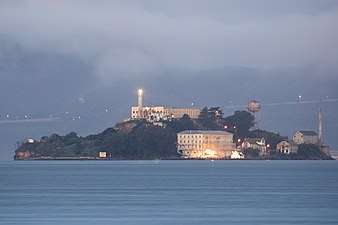
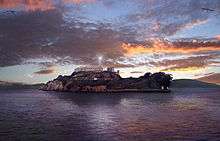
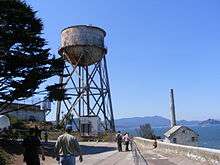
The first European to document the island was Spanish naval officer and explorer Juan Manuel de Ayala during Spanish rule of California, who charted San Francisco Bay in 1775. He named one of the three islands "La Isla de los Alcatraces", which translates as "The Island of the Gannets" but is commonly believed to translate as "The Island of the Pelicans (Spanish for Pelicans is Pelícanos)",[7][8][9][10][11][12] from the archaic Spanish alcatraz ("pelican").
Over the years, the Spanish version "Alcatraz" became popular and is now widely used. In August 1827, French Captain Auguste Bernard Duhaut-Cilly wrote "... running past Alcatraze's (Pelicans) Island ... covered with a countless number of these birds. A gun fired over the feathered legions caused them to fly up in a great cloud and with a noise like a hurricane."[13] The California brown pelican (Pelecanus occidentalis californicus) is not known to nest on the island today. The Spanish built several small buildings on the island and other minor structures.[6]
Fort Alcatraz
The earliest recorded private owner of the island of Alcatraz is Julian Workman, to whom it was given by Mexican governor Pio Pico in June 1846, with the understanding that Workman would build a lighthouse on it.[14] Julian Workman is the baptismal name of William Workman, co-owner of Rancho La Puente and personal friend of Pio Pico. Later in 1846, acting in his capacity as Military Governor of California, John C. Frémont, champion of Manifest Destiny and leader of the Bear Flag Republic, bought the island for $5,000 in the name of the United States government from Francis Temple.[6][15][16]
In 1850, President Millard Fillmore ordered that Alcatraz Island be set aside specifically as a United States military reservation,[11] for military purposes based upon the U.S. acquisition of California from Mexico following the Mexican–American War.[17] Frémont had expected a large compensation for his initiative in purchasing and securing Alcatraz Island for the U.S. government, but the U.S. government later invalidated the sale and paid Frémont nothing. Frémont and his heirs sued for compensation during protracted but unsuccessful legal battles that extended into the 1890s.[17]
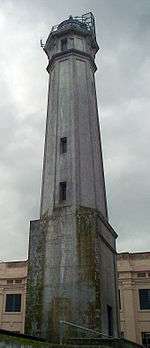
Following the acquisition of California by the United States as a result of the Treaty of Guadalupe Hidalgo (1848) which ended the Mexican–American War, and the onset of the California Gold Rush the following year, the U.S. Army began studying the suitability of Alcatraz Island for the positioning of coastal batteries to protect the approaches to San Francisco Bay. In 1853, under the direction of Zealous B. Tower, the United States Army Corps of Engineers began fortifying the island, work which continued until 1858, when the initial version of Fort Alcatraz was complete. The island's first garrison, numbering about 200 soldiers, arrived at the end of that year.
When the American Civil War broke out in 1861, the island mounted 85 cannons (increased to 105 cannons by 1866) in casemates around its perimeter, though the small size of the garrison meant only a fraction of the guns could be used at one time. At this time it also served as the San Francisco Arsenal for storage of firearms to prevent them falling into the hands of Confederate sympathizers.[18] Alcatraz, built as a "heavily fortified military site on the West Coast", was to form a "triangle of defense" with Fort Point and Lime Point, but the contemplated work on Lime Point was never built. The first operational lighthouse on the West Coast of the United States was also built on Alcatraz. During the war, Fort Alcatraz was used to imprison Confederate sympathizers and privateers on the west coast, but never fired its guns at an enemy.[19]
“Binghamton University archaeologist Timothy de Smet and colleagues located historical remains beneath the former recreation yard of the Alcatraz Federal Penitentiary.” Using ground-penetrating radar data and georectifications, Smet and colleagues uncovered structures, including “a “bombproof” earthwork traverse along with its underlying vaulted brick masonry tunnel and ventilation ducts,” in surprisingly good condition.[20] Archaeologists also found the remains of ammunition magazines, and tunnels below the penitentiary that was built later.[21][22]
Military prison
Because of its isolation from the outside by the cold, strong, tremendous currents of the waters of San Francisco Bay, Alcatraz was used to house soldiers who were guilty of crimes as early as 1859. By 1861, the fort was the military prison for the Department of the Pacific and housed Civil War prisoners of war (POWs) as early as that year.
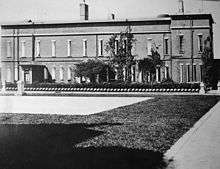
Starting in 1863, the military also held private citizens accused of treason, after the writ of habeas corpus in the United States was suspended.[23]
The Civil War era saw rapid changes in artillery and fortification. Alcatraz's defences were obsolete. Modernization efforts, including an ambitious plan to level the entire island and construct shell-proof underground magazines and tunnels, were undertaken between 1870 and 1876 but never completed (the so-called "parade ground" on the southern tip of the island represents the extent of the flattening effort).[24] Instead, the army switched the focus of its plans for Alcatraz from coastal defense to detention, a task for which it was well suited because of its isolation. In 1867, a brick jailhouse was built (previously inmates had been kept in the basement of the guardhouse), and in 1868, Alcatraz was officially designated a long-term detention facility for military prisoners. The facility was later discontinued for POWs in 1946. Among those incarcerated at Alcatraz were Confederates caught on the West Coast[6] and some Hopi Native American men in the 1870s.[25]
In 1898, the Spanish–American War increased the prison population from 26 to over 450, and from 1905 to 1907 it was commanded by U.S. Army General George W. McIver. After the 1906 San Francisco earthquake, civilian prisoners were transferred to Alcatraz for safe confinement. On March 21, 1907, Alcatraz was officially designated as the Western U.S. Military Prison, later Pacific Branch, U.S. Disciplinary Barracks, 1915.[18] In 1909 construction began on the huge concrete main cell block, designed by Major Reuben Turner, which remains the island's dominant feature. It was completed in 1912.[18]
To accommodate the new cell block, the Citadel, a three-story barracks, was demolished down to the first floor, which was actually below ground level. The building had been constructed in an excavated pit creating a defensive dry moat. The first floor was then incorporated as a basement to the new cell block, giving rise to the popular legend of "dungeons" below the main cell block. The US Disciplinary Barracks was deactivated in October 1933 and transferred to the Bureau of Prisons.[18]
During World War I, the prison held conscientious objectors, including Philip Grosser, who wrote a pamphlet entitled Uncle Sam's Devil's Island about his experiences.[26]
Alcatraz Federal Penitentiary
The United States Disciplinary Barracks on Alcatraz were acquired by the United States Department of Justice on October 12, 1933, and the island became a federal prison in August 1934. Alcatraz was designed to hold prisoners who continuously caused trouble at other federal prisons.[27] At 9:40 am on August 11, 1934, the first batch of 137 prisoners arrived at Alcatraz, arriving by railroad from the United States Penitentiary in Leavenworth, Kansas to Santa Venetia, California, before being escorted to Alcatraz, handcuffed in high security coaches and guarded by 60 special FBI agents, U.S. Marshals and railway security officials.[6][28]
Most of the prisoners were notorious bank robbers and murderers.[6] The prison initially had a staff of 155, including the first warden James A. Johnston and associate warden J. E. Shuttleworth, both considered to be "iron men".[6] The staff were highly trained in security, but not rehabilitation.[6]

During the 29 years it was in use, the jail held some of the most notorious criminals in American history,[6] such as Al Capone, Robert Franklin Stroud (the "Birdman of Alcatraz"), George "Machine Gun" Kelly, Bumpy Johnson, Rafael Cancel Miranda (a member of the Puerto Rican Nationalist Party who attacked the United States Capitol building in 1954),[29] Mickey Cohen, Arthur R. "Doc" Barker, and Alvin "Creepy" Karpis (who served more time at Alcatraz than any other inmate). It also provided housing for the Bureau of Prisons staff and their families.
During its 29 years of operation, the penitentiary claimed that no prisoner successfully escaped. A total of 36 prisoners made 14 escape attempts, two men trying twice; 23 were caught alive, six were shot and killed during their escape, two drowned, and five are listed as "missing and presumed drowned".[30] The most violent occurred on May 2, 1946, when a failed escape attempt by six prisoners led to the Battle of Alcatraz. Perhaps the most famous is the intricate escape carried out on June 11, 1962, by Frank Morris, John Anglin, and Clarence Anglin; the three men are believed to have drowned in their attempt. Contrary to popular belief, it was possible to escape and swim all of the way to shore.[31]
Although most men were caught or drowned before reaching shore, in 1962 prisoner John Paul Scott escaped, and made it to the shore. However, upon reaching the shore he was so weary that he was found unconscious by police and in hypothermic shock. To this day, people compete in the Escape from Alcatraz Triathlon and swim the 1.5 miles to shore.[32]
Post-prison years
Closing of the prison
There are several reasons that Alcatraz closed as a penitentiary in 1963: The penitentiary cost much more to operate than other prisons (nearly $10 per prisoner per day, as opposed to $3 per prisoner per day at Atlanta);[33] half a century of salt water saturation had severely eroded the buildings; and three people had escaped in 1962.
Native American occupation
.jpg)
Alcatraz Island was occupied by Native American activists for the first time on March 8, 1964. The event was reported by, among others, the San Francisco Chronicle and the San Francisco Examiner.
Beginning on November 20, 1969, a group of Native Americans called United Indians of All Tribes, mostly college students from San Francisco, occupied the island to protest federal policies related to American Indians. Some of them were children of Native Americans who had relocated in the city as part of the Bureau of Indian Affairs' (BIA) Indian termination policy, which was a series of laws and policies aimed at the assimilation of Native Americans into mainstream American society, particularly by encouraging Native Americans to move away from the Indian reservations and into cities. A number of employees of the Bureau of Indian Affairs also occupied Alcatraz at that time, including Doris Purdy, an amateur photographer, who later produced footage of her stay on the island.[34]
The occupiers, who stayed on the island for nearly two years, demanded the island's facilities be adapted and new structures built for an Indian education center, ecology center and cultural center. The American Indians claimed the island by provisions of the Treaty of Fort Laramie (1868) between the US and the Sioux; they said the treaty promised to return all retired, abandoned, or out-of-use federal lands to the native peoples from whom they were acquired. Indians of All Tribes then claimed Alcatraz Island by the "Right of Discovery", as indigenous peoples knew it thousands of years before any Europeans had come to North America. Begun by urban Indians of San Francisco, the occupation attracted other Native Americans from across the country, including American Indian Movement (AIM) urban activists from Minneapolis.
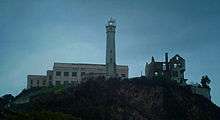
The Native Americans demanded reparation for the many treaties broken by the US government and for the lands that were taken from so many tribes. In discussing the Right of Discovery, the historian Troy R. Johnson states in The Occupation of Alcatraz Island, that indigenous peoples knew about Alcatraz at least 10,000 years before any European knew about any part of North America.
During the nineteen months and nine days of occupation by the American Indians, several buildings at Alcatraz were damaged or destroyed by fire, including the lighthouse keeper's home, the warden's home, the Officers' Club,[35] the recreation hall and the Coast Guard quarters. The origin of the fires is disputed. The U.S. government demolished a number of other buildings (mostly apartments) after the occupation had ended. Graffiti from the period of Native American occupation is still visible at many locations on the island.[36]
During the occupation, President Richard Nixon rescinded the Indian termination policy, designed by earlier administrations to end federal recognition of tribes and their special relationship with the US government. He established a new policy of self-determination, in part as a result of the publicity and awareness created by the occupation. The occupation ended on June 11, 1971.[37]
Landmarks
Part of the Golden Gate National Recreation Area since 1972, the entire Alcatraz Island was listed on the National Register of Historic Places in 1976,[2] and was further declared a National Historic Landmark in 1986.[3][38] In 1993, the National Park Service published a plan entitled Alcatraz Development Concept and Environmental Assessment.[39] This plan, approved in 1980, doubled the amount of Alcatraz accessible to the public to enable visitors to enjoy its scenery and bird, marine, and animal life.[40]
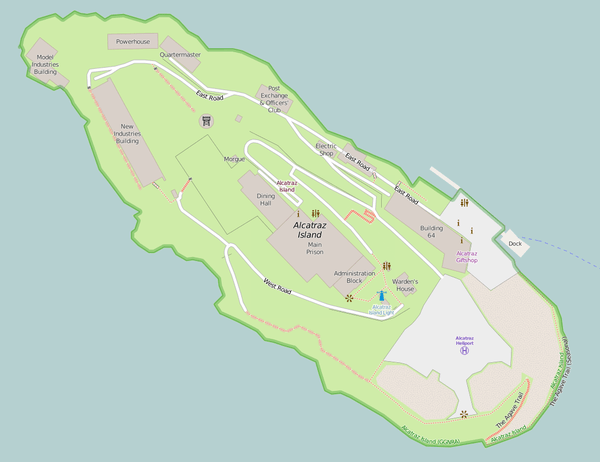
- Barker Beach
- Boat Dock
- Building 64
- Citadel
- Dining Hall
- Former Military Chapel (Bachelor Quarters)
- Helipad
- Library
- Lighthouse
- Main Cellhouse
- Model Industries Building
- Morgue
- New Industries Building
- Officers' Club
- Parade Grounds
- Power House
- Recreation Yard
- Wardens House
- Water Tower
Development
Today, American Indigenous groups, such as the International Indian Treaty Council, hold ceremonies on the island, most notably, their "Sunrise Gatherings" every Columbus Day and Thanksgiving Day.
The Global Peace Foundation proposed to raze the prison and build a peace center in its place. During the previous year, supporters collected 10,350 signatures that placed it on the presidential primary ballots in San Francisco for February 5, 2008.[41] The proposed plan was estimated at $1 billion. For the plan to pass, Congress would have to have taken Alcatraz out of the National Park Service. Critics of the plan said that Alcatraz is too rich in history to be destroyed.[42] On February 6, 2008, the Alcatraz Island Global Peace Center Proposition C failed to pass, with 72% of voters rejecting the proposition.[43]
The coastal environment of the San Francisco Bay Area has caused deterioration and corrosion of building materials throughout Alcatraz. Beginning in 2011, the National Park Service began major renovations on the island, including the installation of solar panels on the cell house roof, slope stabilization near the Warden's House and the stabilization and rehabilitation of the outer cell house walls.
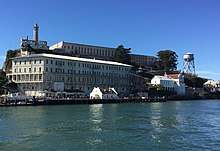
One of San Francisco's major tourist attractions, Alcatraz drew some 1.7 million visitors annually according to a 2018 report.[44] Visitors arrive by ferry, operated under contract by Alcatraz Cruises LLC at Pier 33.[45] The 2018 report indicated that "former prison buildings are being conserved and seismically upgraded and additional areas of the Island are opened to the public as safety hazards are removed".[44]
Art
Alcatraz has been home to several art installations. In 2014, Chinese artist/dissident Ai Weiwei staged an exhibition which explored "questions about human rights and freedom of expression" called @Large.[46] This exhibit included Lego portraits of famous political prisoners. In 2016, Nelson Saiers used math and prison slang as central elements in a six-month installation that called attention to the imposition of long prison sentences.[47][48]
Fauna and flora
Habitat
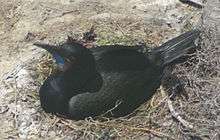
- Cisterns. A bluff that, because of its moist crevices, is believed to be an important site for California slender salamanders.
- Cliff tops at the island's north end. Containing a onetime manufacturing building and a plaza, the area is listed as important to nesting and roosting birds.
- The powerhouse area. A steep embankment where native grassland and creeping wild rye support a habitat for deer mice.
- Tide pools. One of the only complexes in the San Francisco Bay, the island's tide pools were created by quarrying activities, and contain a variety of typical invertebrate species.[49]
- Western cliffs and cliff tops. Rising to heights of nearly 100 feet (30 m), they provide nesting and roosting sites for seabirds including pigeon guillemots, cormorants, Heermann's gulls, and western gulls. Harbor seals can occasionally be seen on a small beach at the base.
- The parade grounds. Carved from the hillside during the late 19th century and covered with rubble since the government demolished guard housing in 1971, the area has become a habitat and breeding ground for black-crowned night herons, western gulls, slender salamanders, and deer mice.
- The Agave Path, a trail named for its dense growth of agave. Located atop a shoreline bulkhead on the south side, it provides a nesting habitat for night herons.
- Alcatraz prison and its surroundings.
Flora
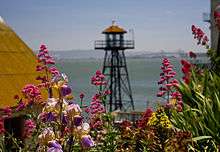
Gardens planted by families of the original Army post, and later by families of the prison guards, fell into neglect after the prison closure in 1963. After 40 years, they are being restored by a paid staff member and many volunteers, thanks to funding by the Garden Conservancy and the Golden Gate National Parks Conservancy. The untended gardens had become severely overgrown and had developed into a nesting habitat and sanctuary for numerous birds. Now, areas of bird habitat are being preserved and protected, while many of the gardens are being restored to their original state.
In clearing out the overgrowth, workers found that many of the original plants were growing where they had been planted – some more than 100 years ago. Numerous heirloom rose hybrids, including a Welsh rose (Bardou Job) that had been believed to be extinct, have been discovered and propagated. Many species of roses, succulents, and geraniums are growing among apple and fig trees, banks of sweet peas, manicured gardens of cutting flowers, and wildly overgrown sections of native grasses with blackberry and honeysuckle. [50]
Climate
| ||||||||||||||||||||||||||||||||||||||||||||||||||||||||||||||||||||||||||||||||||||||||||||||||||||||||||||||||||||||||||||
In popular culture
Alcatraz Island appears often in media and popular culture, including films dating from 1962: The Book of Eli (2010), X-Men: The Last Stand (2006), Catch Me If You Can (2002), The Rock (1996), Murder in the First (1995), Escape from Alcatraz (1979), The Enforcer (1976), Point Blank (1967) , Birdman of Alcatraz (1962) and J. J. Abrams' 2012 television series Alcatraz.
It also was featured in the Yu-Gi-Oh! Duel Monsters anime, in the book Al Capone Does My Shirts, in the video game Tony Hawk's Pro Skater 4 as a playable level, and in the video game Call of Duty: Black Ops II in a downloadable zombie survival map called "Mob of the Dead". It is also showcased as a playable racetrack in the 1997 arcade racing video game San Francisco Rush the Rock - Alcatraz Edition. Alcatraz has also been portrayed often as a safe haven or base of operations in many post-apocalyptic movies, such as The Book of Eli.
Alcatraz even appears in The Alchemyst and The Sorceress by author Michael Scott and is depicted as a prison for the immortal Perenelle Flamel.
Alcatraz is featured in the episode "Bird Mummy of Alcatraz" in the children's program, Mummies Alive! and was also featured in a mission in the video game Watch Dogs 2. Alcatraz is also featured as a downloadable map in the video game The Escapists. Alcatraz is also featured in the video game Call of Duty: Black Ops 4's Zombie Level "Blood of the Dead".
Gallery
 A panorama of Alcatraz as viewed from San Francisco Bay, facing east. Sather Tower and UC Berkeley are visible in the background on the right. (Drag image left and right to show full panorama.)
A panorama of Alcatraz as viewed from San Francisco Bay, facing east. Sather Tower and UC Berkeley are visible in the background on the right. (Drag image left and right to show full panorama.)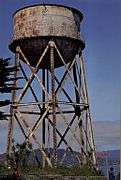 Different view of the Water Tower built in 1940.
Different view of the Water Tower built in 1940.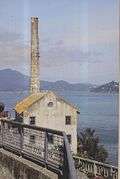 Alcatraz Utility House and Power Plant Chimney, built in 1939.
Alcatraz Utility House and Power Plant Chimney, built in 1939. School House (two story building in the middle) and the Electric Repair shop (foreground) built in 1930s.
School House (two story building in the middle) and the Electric Repair shop (foreground) built in 1930s.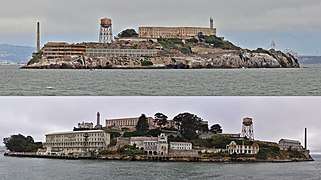 Views of both long sides of the island.
Views of both long sides of the island. Alcatraz Island harbor guards tower.
Alcatraz Island harbor guards tower.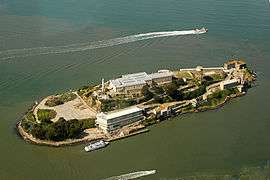 Alcatraz Island view from the west. Image shot from an altitude of approximately 1,800 ft (549 m).
Alcatraz Island view from the west. Image shot from an altitude of approximately 1,800 ft (549 m).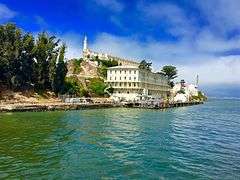 Alcatraz view from tour boat.
Alcatraz view from tour boat.
See also
References
- "Alcatraz Island". Encyclopædia Britannica Online. Encyclopædia Britannica. 2009. Retrieved August 20, 2009.
- "National Register Information System". National Register of Historic Places. National Park Service. January 23, 2007.
- "Alcatraz Island". National Historic Landmark summary listing. National Park Service. Archived from the original on October 12, 2007. Retrieved October 22, 2007.
- "Alcatraz | Spanish Pronunciation". SpanishDict. Retrieved June 5, 2020.
- Odier, Odier (1982). The Rock: A History of Alcatraz: The Fort/The Prison. L'Image Odier. ISBN 0-9611632-0-8.
- "This Is An Alcatraz Documentary (Part 1)". Narrated by Howard Duff. 1971. Retrieved August 30, 2012.
- "Alcatraz Island". Geographic Names Information System. United States Geological Survey.
- "The March of Portolá and the Log of the San Carlos – Zoeth S. Eldredge & E. J. Molera – Log of the San Carlos". Books-about-california.com. Archived from the original on February 13, 2011. Retrieved January 24, 2011.
- "The History of Alcatraz Island". Alcatrazhistory.com. Retrieved January 24, 2011.
- "History: Military Fortress". Alcatrazcruises.com. Archived from the original on November 19, 2010. Retrieved January 24, 2011.
- "BOP: Alcatraz". Bop.gov. Archived from the original on January 9, 2011. Retrieved January 24, 2011.
- "Alcatraz Island – History & Culture (U.S. National Park Service)". Nps.gov. March 27, 2010. Archived from the original on February 28, 2011. Retrieved January 24, 2011.
- Auguste Duhaut-Cilly (1999). A Voyage to California, the Sandwich Islands, and Around the World in the Years 1826–1829. University of California Press. p. 284. ISBN 978-0-520-21752-2.
- The Rock (1915). "A Brief History of the Island of Alcatraz". The Rock. Improvement Fund, Pacific Branch United States Disciplinary Barracks, Alcatraz, California. 1 (January): 3.
- "Full text of "The expeditions of John Charles Frémont"". Retrieved January 24, 2011.
- "h2g2 – Alcatraz, San Francisco, California, USA". BBC. Retrieved January 24, 2011.
- "Alcatraz-World War II in the San Francisco Bay Area: A National Register of Historic Places Travel Itinerary". Nps.gov. Retrieved January 24, 2011.
- Hannings, Bud (March 2005). Forts of the United States: An Historical Dictionary, 16th Through 19th Centuries. Jefferson, North Carolina: McFarland & Co Inc. p. 36. ISBN 978-0-7864-1796-4.
- "Historic Posts, Camps, Stations and Airfields: Post at Alcatraz Island". Militarymuseum.org. Archived from the original on February 6, 2011. Retrieved January 24, 2011.
- Brhel, John. "High-tech laser scans uncover hidden military traverse at Alcatraz Island - Binghamton News". News - Binghamton University. Retrieved March 5, 2020.
- "Archeologists find hidden tunnels below Alcatraz prison". National Post. March 6, 2019. Retrieved March 7, 2019.
- "The fate of the historic fortifications at Alcatraz island based on terrestrial laser scans and ground-penetrating radar interpretations from the recreation yard". Near Surface Geophysics. January 14, 2019. Retrieved March 7, 2019.
Alcatraz is less known in its former military role as a 19th-century coastal fortification protecting the interests of a rapidly westward-expandingnation during the turbulent era of Manifest Destiny, the 1849 Gold Rush and the Civil War. The fortification, with its underground ammunition magazines and tunnels, is important from a military history perspective, marking the transition to earthen structures from the traditional brick and masonry constructions that characterized earlier 19th-century coastal defences.
- "Civil War at Alcatraz". National Park Service. March 19, 2015. Retrieved March 7, 2019.
the army continued to work on Alcatraz throughout 1860 and 1861, expanding and improving the island’s existing fortifications. The military also used the island as a training ground for soldiers. New troops continually arrived on the island, underwent training, and departed for other assignments. With many new enlistees, the military personnel on Alcatraz increased to over 350 by the end of April 1861. The army slowly increased the number of men assigned to Alcatraz throughout the Civil War, reaching a high point of 433 men in early 1865. The army shipped most of these soldiers out to the Southwestern frontier; however, some were sent to battlefields in the East.
- Alcatraz Preservation Project: Exposing the Layers of An American Landmark (pamphlet), Golden Gate National Parks Conservancy, 2003.
- "The most painful story of resistance to assimilation programs and compulsory school attendance laws involved the Hopis in Arizona, who surrendered a group of men to the military rather than voluntarily relinquish their children. The Hopi men served time in federal prison at Alcatraz". Child, Brenda J. (February 2000). Boarding School Seasons: American Indian Families, 1900–1940. University of Nebraska Press. p. 13. ISBN 0-8032-6405-4.
- Grosser, P., Block, H., Blackwell, A. S., & Berkman, A. (1933). Uncle Sam's Devil's Island: Experiences of a Conscientious Objector in America during the World War. Boston
- Oliver, Marilyn Tower (1998). Alcatraz Prison in American HIstory. Berkley Heights, NJ: Enslow Publishers Inc. p. 9. ISBN 0-89490-990-8.
- "For Desperate or Irredeemable Types United States Federal Penitentiary Alcatraz". A History of Alcatraz Island, 1847–1972, Historic Resources Study. Retrieved September 6, 2012.
- "Former Alcatraz inmate speaks about his time", San Francisco Examiner, by D. Morita; October 9, 2009
- "Alcatraz Escape Attempts". Alcatrazhistory.com. Retrieved January 24, 2011.
- Janssen, Volker (August 2010). "Alcatraz: The Gangster Years. By David Ward with Gene Kassebaum . (Berkeley, University of California Press, 2009. 224 pp. $34.95) Hard Time at Tehachapi: California's First Women's Prison. By Kathleen Cairns . (Albuquerque, University of New Mexico Press, 2009. 584 pp. $27.95)". Pacific Historical Review. 79 (3): 471–474. doi:10.1525/phr.2010.79.3.471. ISSN 0030-8684.
- Klein, Christopher. "10 Things You May Not Know About Alcatraz". HISTORY. Retrieved February 16, 2020.
- Ocean View Publishing Company. "A Brief History of Alcatraz, p. 5". Alcatrazhistory.com. Retrieved July 18, 2012.
- Occupation of Alcatraz, 11-29-1969. YouTube. November 27, 2008.
- "Alcatraz Origins". Federal Bureau of Prisons. March 11, 1016. Retrieved February 7, 2019.
much damage occurred (graffiti, vandalism, and a fire that destroyed the lighthouse keeper's home, the Warden's home, and the Officers' Club)
- Alcatraz Island Archived September 23, 2006, at the Wayback Machine, California State University Long Beach
- Indians of All Tribes, Alcatraz Is Not an Island, Berkeley, Wingbow Press, 1972
- Stephen A. Haller (April 15, 1985). "National Register of Historic Places Inventory-Nomination: Alcatraz Island / La Isla de los Alcatraces / Fort Alcatraz / The Post at Alcatraz / Pacific Branch, U.S. Military Prison / U.S. Disciplinary Barracks, Alcatraz Island / United States Penitentiary ad Alcatraz Island" (PDF). National Park Service. Retrieved June 21, 2009. and Accompanying 18 photos, exterior and interior, from 1985, 1980, and undated. (4.03 MB)
- https://web.archive.org/web/20061015075505/https://www.nps.gov/archive/goga/admin/planning/alca-eis/doc/chap1.doc
- Adams, Gerald D., Alcatraz Proposal Highlights Wildlife Plan Would Open Up More of Rock, San Francisco Examiner (July 27, 1993), News section, p. A1.
- "Voters consider changing Alcatraz to peace center". Reuters. February 4, 2008.
- Locke, Michelle (February 2, 2008). "LJWorld.com / Activist wants to transform Alcatraz into global peace center". .ljworld.com. Retrieved January 24, 2011.
- "Elections and Results | KNTV Bay Area". NBC 11. Retrieved January 24, 2011.
- "GGNRA is one of the Largest Urban Parks in the World". Hornblower. October 9, 2018. Retrieved March 7, 2019.
- "Directions". National Park Service. January 7, 2019. Retrieved March 7, 2019.
- "@Large Ai Weiwei on Alcatraz". NPS.GOV.
- Levi, Ryan. "Alcatraz Displays Irrational Numbers & Irrationally Long Prison Sentences". KQED.ORG.
- Andrews, David. "'Hung Out to Dry': New Alcatraz art exhibit examines prison industrial complex". SFGATE.COM.
- LSA Associates, Inc. (July 9, 1993). Alcatraz Development Concept Plan and Environmental Assessment. Richmond, CA. p. 10. Retrieved October 11, 2019.
- Lagos, Marisa. (2008) Gardens on Alcatraz Island blooming again. SFGate. Retrieved from July 21st, 2020.
- "NASA Earth Observations Data Set Index". NASA. Retrieved January 30, 2016.
Further reading
- Erwin N. Thompson. "The Rock: A history of Alcatraz Island, 1847–1972" (PDF). National Park Service. United States Department of Interior.
- The Rock (1915). "A Brief History of the Island of Alcatraz (continued in multiple issues)". The Rock. Improvement Fund, Pacific Branch United States Disciplinary Barracks, Alcatraz, California. 1 (January): 3.
External links
| Wikimedia Commons has media related to Alcatraz Island. |
- Official website

- AlcatrazHistory.com: Alcatraz History website – homepage
- Alldocumentaries.org: Alcatraz History documentary movie
- American Devils Island Holds Toughest Prisoners – Popular Science (February 1935).
- Federal Bureau of Prisons.gov: "A Brief History of Alcatraz"
- California State Military Museum.org: The Post at Alcatraz Island
- 2012 KDRTradio.org: Interview with former Alcatraz convict Robert Luke
- Report on the 1962 Alcatraz escape incident – (from the FBI FOIA electronic reading room).
- Mapicurious.com: Map of Alcatraz – with marker pictures.
- Alcatraz: A Prison as Disneyland. Chris Hedges (December 2014).
- Alcatraz Island, Part of Golden Gate National Recreation Area, National Park Service at Google Cultural Institute



